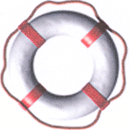Online No-Limit Texas Hold’em SnG Tournaments
I’ve been playing a lot of online SnGs. What the hell is that, you may ask? An SnG stands for Sit & Go, which is a type of short, 10-player poker tournament (in this case, Texas Hold’em), typically played in online poker rooms. There is a buy-in fee and a house-fee. Each player’s buy-in goes into a prize-pool, and the poker room collects an additional house fee (usually 10% of the buy-in) for providing the service. The players then all get a fixed amount of chips and then play until one player has them all. The typical prizes are 20% of the prize-pool for finishing in 3rd place, 30% for finishing in 2nd place, and 50% for finishing in 1st. To ensure the tournament is quick, and to force an ending if the players are evenly matched, the blinds (like antes) go up every 10 hands.
I practiced extensively on Poker Academy Pro‘s free online server. There, we host play-money tournaments where the ‘pretend’ buy-in is $5, and the house fee is of course $0. I logged 77 tournaments there so far, and have accumulated a bankroll of $243. That works out to an average profit of $3.15 per tournament. In business terms that is a 63% return on investment (ROI). That currently ranks me at 6th place out of 257 ranked players in the PA Online. This of course gave me some experience in the game and some added confidence in my abilities. But would results like this carry to real poker? It’s hard to trust results from play-money where nothing but pride is at stake. And in real games you have to pay the house-fee as well, which puts a significant dent in your ROI.
So I’ve been playing on Party Poker (the world’s largest online poker room) lately to put my strategy to the test. I deposited $100 into the account and have stuck exclusively to playing $10+$1 tournaments. That’s $10 to the prize pool and $1 to the house. A single tournament typically lasts 45 minutes. I usually play four at a time — a single SnG doesn’t keep my ADHD reigned in. While four simultaneous tournaments is intense, it doesn’t seem to matter much. I’ve now logged 62 tournaments in total. I’ve earned a net profit of $168, which works out to $2.71 per tournament. This is a return on investment of 25%. Since I can play about 5 tournaments per hour, this would equate to a wage of $13.50/hour. It’s not exactly time to quit my day job 🙂
My general strategy has been to play very boring poker for the first while. By boring I mean uncreative and tight. I play a very risk-averse style. I play only premium hands, but will limp with anything if I can see the flop without getting raised. The general idea is to not take any risks, but if I can manage to flop a monster hand, I should use the opportunity to build up my stack. The main idea, otherwise is to just wait and survive. This stage is relatively easy, especially since I’m playing four tables at once, there’s not much time to think hard about things.
When the really bad players start to drop out and it gets down to five or six players I start to pay a little more attention. By now, the blinds are starting to get larger as well and it is no longer cheap to see a flop, nor is it bad to steal the blinds outright. I start to pay a little more attention to the styles of the remaining players. If any of these players have been paying attention to me, they will have observed me playing very conservatively up to this point and may be taken by surprise when I start to get much more aggressive. Still, the overriding goal is to make the money. this means surviving to at least 3rd place. The prize for finishing third is $20, so just making it there is a $9 profit.
The really critical part comes when it gets down to just four players. This is called being on the bubble. No one wants to be the guy that finishes just out of the money. Most players get very risk averse and conservative at this stage. One of my biggest advantages, besides knowing how to survive to the bubble, is that a huge number of players play very badly on the bubble. It amazes me how many times I’ve been the smallest stack on the bubble and the following occurs. The blinds get pushed around and steadily erode my stack. All the other three players have to do is wait a few hands for the blinds to force me all-in and out of the game. But invariably, two geniuses get in a battle and one of the bigger stacks ends up busting out. I sneak by into third place with a small chance of getting lucky and making second or first.
Other players are the exact opposite — way too timid on the bubble. They are so scared of bubbling out you can constantly steal their blinds without a fight. Since the blinds are significant at this point you can build up a decent stack lead just by stealing the blinds. Since they are playing so tight, as soon as you feel any pressure back from them you know the have a strong hand and you can get out cheap. Even if you loose a little this way, you’ve won so much from all the steals it doesn’t make a dent. It’s all about being aggressive, but picking your spots.
In any event, I’ve found the SnG format to be the softest real-money game on the internet. Furthermore, it also has the lowest variance, by playing a high volume of low buy-in tournaments. Next I’m going to move up to higher stakes ($20 + $2). If I can sustain the same winning rate, I’ll effectively double my wage. However, as the stakes increase, the quality of the opposition tends to increase as well. Thus, my ROI may not be as high at the next level. I guess we’ll find out.







I’m that skinny hippie freak leading your cheering section.
hmmm, that sounds eerily familiar… it’s like deja vous, or sumpthin’. it’s almost as though i wrote it, eleven years ago…
welcome to 2 years ago